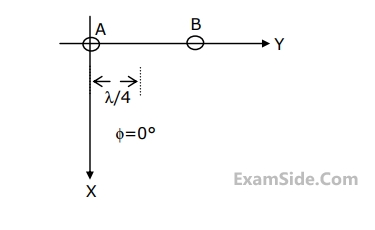1
GATE ECE 2002
Subjective
+5
-0
Consider a linear array of two half - wave dipoles A and B as shown in Fig. The dipoles are $${\lambda \over 4}$$ apart and are excited in such a way that the current on element B lags that on element A by $${90^0}$$ in phase

(a) Obtain the expression for the radiation pattern for E in the XY plane, i.e.,$$\left( {\theta = {{90}^0}} \right)$$.
(b) Sketch the radiation pattern obtained in (a).

2
GATE ECE 1999
Subjective
+5
-0
The average power of an omni-directional antenna varies as the magnitude of cos($$\theta $$) where $$\theta $$ is the azimuthal angle. Calculate the maximum Directive Gain of the antenna and the angles at which it occurs.
3
GATE ECE 1997
Subjective
+5
-0
A dipole antenna has a sin$$\theta $$ radiation pattern where the angle $$\theta $$ is measured from the axis of the dipole. The dipole is vertically located above an ideal ground plane (Fig.). What should be the height of the dipole H in terms of wave length so as to get a null in the radiation pattern at an angle of 450 from the ground plane? Find the direction of maximum radiation also.


4
GATE ECE 1996
Subjective
+5
-0
Two isotropic antennas A and B from an array as shown in Fig. The currents fed to the two antennas are $${{\rm I}_0}\,\angle 0$$ and $${{\rm I}_0}\,\angle \alpha $$ respectively. What should be the value of $$\alpha $$ so that the radiation pattern has a null at $$\theta = {30^ \circ }$$. Find the direction of the maximum radiation for that value of $$\alpha $$ and draw the radiation pattern. ($$\lambda \,\,$$ is the wavelength of operation)


Questions Asked from Antennas (Marks 5)
Number in Brackets after Paper Indicates No. of Questions
GATE ECE Subjects
Network Theory
Control Systems
Electronic Devices and VLSI
Analog Circuits
Digital Circuits
Microprocessors
Signals and Systems
Representation of Continuous Time Signal Fourier Series Fourier Transform Continuous Time Signal Laplace Transform Discrete Time Signal Fourier Series Fourier Transform Discrete Fourier Transform and Fast Fourier Transform Discrete Time Signal Z Transform Continuous Time Linear Invariant System Discrete Time Linear Time Invariant Systems Transmission of Signal Through Continuous Time LTI Systems Sampling Transmission of Signal Through Discrete Time Lti Systems Miscellaneous
Communications
Electromagnetics
General Aptitude